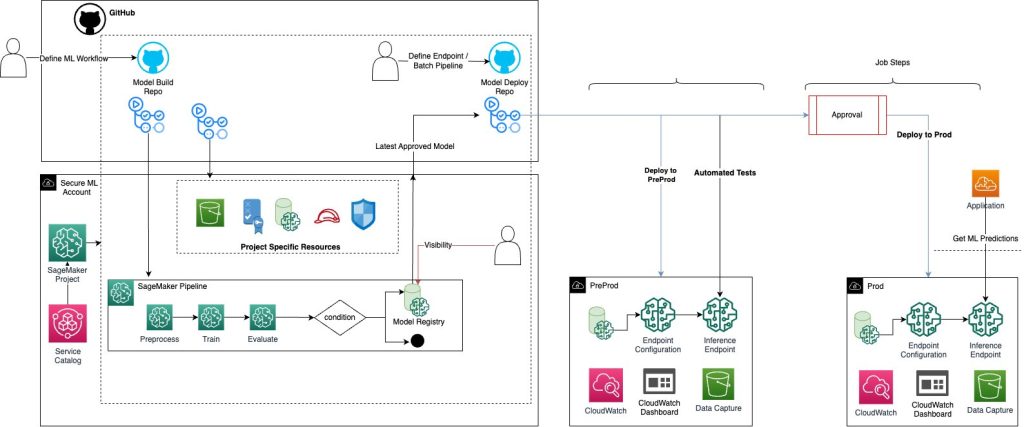Artificial Intelligence
Category: AWS Identity and Access Management (IAM)
Implement a secure MLOps platform based on Terraform and GitHub
Machine learning operations (MLOps) is the combination of people, processes, and technology to productionize ML use cases efficiently. To achieve this, enterprise customers must develop MLOps platforms to support reproducibility, robustness, and end-to-end observability of the ML use case’s lifecycle. Those platforms are based on a multi-account setup by adopting strict security constraints, development best […]
Configure fine-grained access to Amazon Bedrock models using Amazon SageMaker Unified Studio
In this post, we demonstrate how to use SageMaker Unified Studio and AWS Identity and Access Management (IAM) to establish a robust permission framework for Amazon Bedrock models. We show how administrators can precisely manage which users and teams have access to specific models within a secure, collaborative environment. We guide you through creating granular permissions to control model access, with code examples for common enterprise governance scenarios.
Multi-account support for Amazon SageMaker HyperPod task governance
In this post, we discuss how an enterprise with multiple accounts can access a shared Amazon SageMaker HyperPod cluster for running their heterogenous workloads. We use SageMaker HyperPod task governance to enable this feature.
Secure distributed logging in scalable multi-account deployments using Amazon Bedrock and LangChain
In this post, we present a solution for securing distributed logging multi-account deployments using Amazon Bedrock and LangChain.
Accelerate digital pathology slide annotation workflows on AWS using H-optimus-0
In this post, we demonstrate how to use H-optimus-0 for two common digital pathology tasks: patch-level analysis for detailed tissue examination, and slide-level analysis for broader diagnostic assessment. Through practical examples, we show you how to adapt this FM to these specific use cases while optimizing computational resources.
Implement secure API access to your Amazon Q Business applications with IAM federation user access management
Amazon Q Business provides a rich set of APIs to perform administrative tasks and to build an AI assistant with customized user experience for your enterprise. In this post, we show how to use Amazon Q Business APIs when using AWS Identity and Access Management (IAM) federation for user access management.
Build private and secure enterprise generative AI applications with Amazon Q Business using IAM Federation
Amazon Q Business is a conversational assistant powered by generative artificial intelligence (AI) that enhances workforce productivity by answering questions and completing tasks based on information in your enterprise systems, which each user is authorized to access. In an earlier post, we discussed how you can build private and secure enterprise generative AI applications with Amazon Q Business and AWS IAM Identity Center. If you want to use Amazon Q Business to build enterprise generative AI applications, and have yet to adopt organization-wide use of AWS IAM Identity Center, you can use Amazon Q Business IAM Federation to directly manage user access to Amazon Q Business applications from your enterprise identity provider (IdP), such as Okta or Ping Identity. Amazon Q Business IAM Federation uses Federation with IAM and doesn’t require the use of IAM Identity Center. This post shows how you can use Amazon Q Business IAM Federation for user access management of your Amazon Q Business applications.
Implement exact match with Amazon Lex QnAIntent
This post is a continuation of Creating Natural Conversations with Amazon Lex QnAIntent and Amazon Bedrock Knowledge Base. In summary, we explored new capabilities available through Amazon Lex QnAIntent, powered by Amazon Bedrock, that enable you to harness natural language understanding and your own knowledge repositories to provide real-time, conversational experiences. In many cases, Amazon […]
Translate multiple source language documents to multiple target languages using Amazon Translate
Enterprises need to translate business-critical content such as marketing materials, instruction manuals, and product catalogs across multiple languages to communicate with a global audience of customers, partners, and stakeholders. Identifying the source language in each document before calling a translate job creates complexities and adds another step to your workflow. For example, an international product […]
Secure Amazon SageMaker Studio presigned URLs Part 1: Foundational infrastructure
You can access Amazon SageMaker Studio notebooks from the Amazon SageMaker console via AWS Identity and Access Management (IAM) authenticated federation from your identity provider (IdP), such as Okta. When a Studio user opens the notebook link, Studio validates the federated user’s IAM policy to authorize access, and generates and resolves the presigned URL for […]









